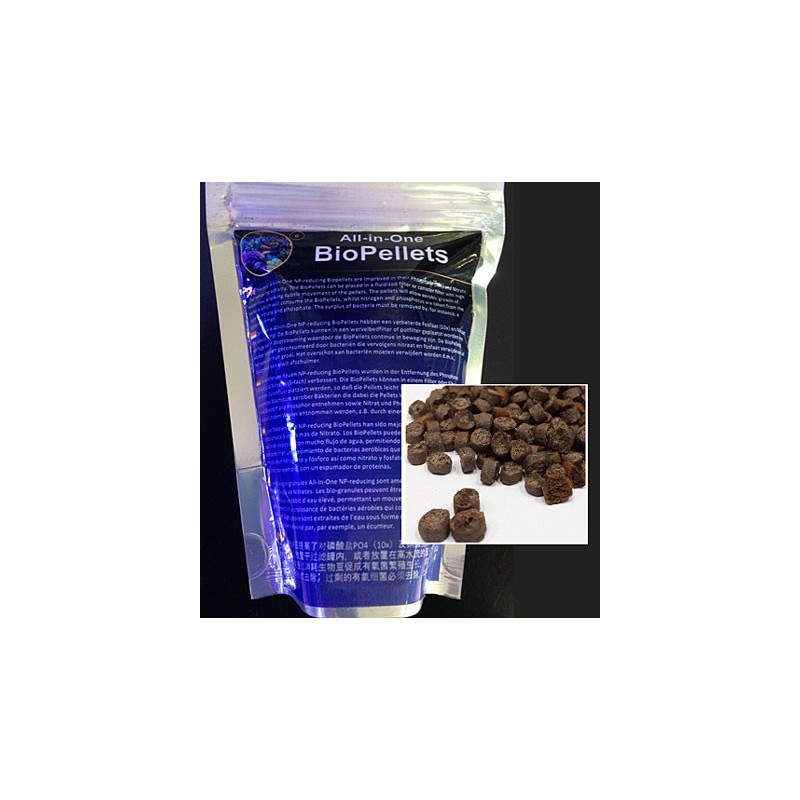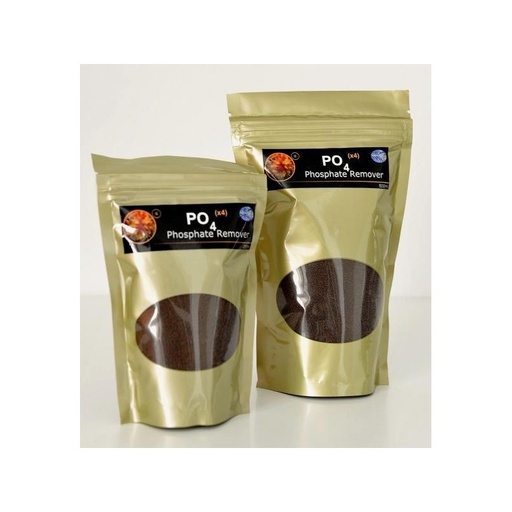
NP Biopellets All In One Biopellets 250ml REEF INTEREST

NP Biopellets All In One Biopellets 250ml REEF INTEREST
2Anteriormente, Reef Interests fue el primero en desarrollar y presentar los BioPellets reductores de NP, que en su mayoría eliminan productos de desecho de nitrógeno y junto con una menor cantidad de fosfatos. DVH ha trabajado arduamente para desarrollar un producto nuevo y mejor llamado All-In-One BioPellets.
Después de 4 años de desarrollo e investigación, DVH se complace en poder presentar los biopellets todo en uno Reef Interests (patente pendiente), que se pueden usar para eliminar de manera más eficiente tanto el nitrógeno (5x) como los fosfatos (10x- 20x) sin la necesidad de utilizar sustratos de eliminación de fosfato separados. Ahora, por primera vez, no es necesario comprar medios GFO costosos para la reducción de PO4 y Biopellets para la reducción de nitratos. Con este producto todo en uno fácil de usar, Reef Interests All-In-One BioPellets lo hará todo a un costo asequible sin necesidad de 2 reactores separados para GFO y Biopellets.
Los efectos positivos de los BioPellets reductores de NP sobre la calidad del agua se basan en el principio de inmovilización. Los productos de desecho del agua, principalmente nitratos y fosfatos, se convierten en bacterias. Este proceso mantiene limpia el agua del acuario. La nueva fórmula All-In-One Biopellets está compuesta por compuestos altamente purificados, para garantizar el uso seguro de los productos Reef Interests en tanques marinos ocupados por animales sensibles y preciosos como corales, invertebrados, peces, etc.
Los gránulos permitirán el crecimiento aeróbico de bacterias que, en consecuencia, consumirán nitrato y fosfato simultáneamente. Las bacterias consumirán el carbono de los BioPellets todo en uno Reef Interests, mientras que el nitrógeno y el fósforo se tomarán del agua como nitrato y (orto) fosfato. Esta conversión de BioPellets orgánicos (junto con nitrógeno y fósforo inorgánicos) en biomasa microbiana se llama inmovilización. A diferencia de nuestros Biopellets “antiguos”, hemos observado que los Biopellets todo en uno funcionan mejor con un flujo de agua muy alto.
Cómo utilizar:
Reef Interests recomienda remojar los biopellets todo en uno durante un período de 24 horas en agua de acuario marino antes de usarlos en el reactor de su acuario. Esto asegurará un volteo más uniforme una vez agregado al reacotor. All-In-One BioPellets es más pesado que NP BioPellets y requiere una mayor velocidad de flujo para voltear el medio. Por ejemplo, un tanque de 700 litros (185 galones) con un filtro fluidizado que contiene 2 litros de biopellets todo en uno requerirá un flujo mínimo de 2000-3000 l / h (528-792 GPH).
Resultados después de 10 meses: la carga biológica en un acuario de 700 litros (185 galones) contiene aproximadamente 50 peces y después de 10 meses de pruebas, tanto los nitratos como los fosfatos eran indetectables con los kits de prueba estándar de nitrato y fosfato para acuarios con el uso de 2 litros de medio.
El excedente de bacterias será consumido por organismos que se alimentan por filtración y suspensión, como esponjas y corales, o se lo quitará un skimmer de proteínas. Además, con un régimen de alimentación elevado, Reef Interests aconseja utilizar una esponja de filtro simple en la salida de su filtro fluidizado para eliminar el exceso de bacterias que, de lo contrario, enturbiarían ligeramente el agua.
En promedio, los Biopellets All-In-One tardan de 1 a 4 semanas en dar lugar a suficientes bacterias para permitir que bajen los niveles de nitrato y fosfato. Es importante destacar que permita que los habitantes de su acuario se adapten a su nuevo entorno aumentando lentamente el nivel de BioPellets durante un período de varias semanas. Agregue gránulos adicionales cada 3-6 meses dependiendo del consumo de Biopellet y los niveles de NO3 y PO4.
Se recomiendan 500-1000 ml de biopellets por cada 100 galones.
Previously, Reef Interests was the first to develop and present the NP reducing BioPellets which are mostly removing Nitrogen waste products and along with a smaller amount of Phosphates. DVH has been hard at work developing a new and better product called All-In-One BioPellets.
After 4 years of development and research DVH is very pleased to be able to present the Reef Interests All-In-One Biopellets (Patent Pending), which can be used to more efficiently remove both Nitrogen (5x) as well as Phosphates (10x-20x) without the need of using separate phosphate removing substrates. Now for the 1st time there is no need to have to purchase expensive GFO media for PO4 reduction and Biopellets for Nitrate reduction. With this All-In-One simple to use product, Reef Interests All-In-One BioPellets will do it all at an affordable cost with no need for 2 seperate reactors for GFO and Biopellets.
The positive effects of NP-reducing BioPellets on water quality are based on the principle of immobilization. Waste products from the water, mainly nitrate and phosphate, are converted into bacteria. This process keeps the aquarium water clean. The new formula All-In-One Biopellets are composed of highly purified compounds, to ensure the safe use of Reef Interests products in marine tanks occupied by sensitive and precious animals such as corals, invertebrates, fish etc…
The pellets will allow aerobic growth of bacteria which consequently will consume nitrate and phosphate simultaneously. The bacteria will use up the carbon from the Reef Interests All-In-One BioPellets whilst nitrogen and phosphorus are taken from the water as nitrate and (ortho)phosphate. This conversion of organic BioPellets (together with inorganic nitrogen and phosphorus) into microbial biomass is called immobilization. In contrast to our “old” Biopellets, we have observed that the All-In-One Biopellets work best with very high water flow.
How to Use:
Reef Interests reccomends soaking All-In-One Biopellets for a period of 24 hours in marine aquarium water before use in your aquarium reactor. This will insure more uniform tumbling once added to the reacotor. All-In-One BioPellets is heavier than NP BioPellets and it requires a higher flow rate to tumble the media. For example, a 700 liter tank (185 gallons) with a fluidized filter containing 2 liter of All-In-One Biopellets will require a minimal flow through of 2000-3000 l/h (528-792 GPH).
Results after 10 months: The bioload on a 700 liter aquarium (185 gallons) contains approximately 50 fish and after 10 months of testing both nitrates and phosphates were undetectable with standard nitrate and phosphate aquarium test kits with the use of 2 liters of media.
The surplus of bacteria will be consumed by filter and suspension feeding organisms, such as sponges and corals, or skimmed off by a protein skimmer. In addition, with a high feeding regime, Reef Interests advises to use a simple filter sponge on the outlet of your fluidized filter to remove excess of bacteria which will otherwise cloud your water slightly.
On average the All-In-One Biopellets takes 1-4 weeks to give rise to sufficient bacteria to allow nitrate and phosphate levels to drop. Importantly, allow your aquarium inhabitants to adjust to their new environment by slowly increasing the level of BioPellets over a period of several weeks. Add extra pellets every 3-6 months dependent on Biopellet consumption and levels of NO3 and PO4.
500-1000mL of biopellets is recommended per 100 gallons.

To install this Web App in your iPhone/iPad press ![]() and then Add to Home Screen.
and then Add to Home Screen.





